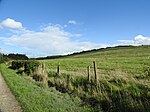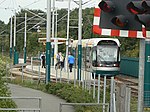Rise Park, Nottingham

Rise Park is a suburb of Nottingham four miles north of the City Centre and three miles north-east of junction 26 of the M1 motorway. It comprises approximately 1500 homes, primarily privately owned houses and bungalows, and a small number of low rise, three-storey flats. Construction of the estate began in the early 1960s, starting at the bottom of the hill to the west and gradually spreading upwards and eastwards to be completed in the early 1970s. It was built on the former site of Rise Farm (known as Bulwellrise Farm until around 1900), the southern boundary of which ran along the edge of what is now Rise Park Road, Langbank Avenue and Bracadale Road. The farmhouse had stood on what would now be the south-east corner of Haverill Crescent. On the western boundary ran a railway line, closed in the mid-1960s and now a tree-lined footpath. To the north is Bestwood Country Park and to the east is another housing estate built in the late 1970s on the site of Home Farm. Rise Park primary and nursery school was originally opened as separate infant and junior schools in 1971, built on land once belonging to Top Valley Farm, as was Top Valley Academy which opened in September 1973. Rise Park has had a small parade of shops since 1969 or 1970. An additional supermarket (originally Grandways and later Kwik-Save) opened for business in 1977 but this was later demolished and replaced with McCracken Close and new homes in the 2010s. Next to the shopping area is a church opened in 1968 and a bus terminus with frequent links to the City Centre and surrounding areas of Arnold and Bulwell. The market town of Hucknall is close by.
Excerpt from the Wikipedia article Rise Park, Nottingham (License: CC BY-SA 3.0, Authors, Images).Rise Park, Nottingham
Roseneath Avenue, Nottingham Rise Park
Geographical coordinates (GPS) Address Nearby Places Show on map
Geographical coordinates (GPS)
| Latitude | Longitude |
|---|---|
| N 53.012 ° | E -1.176 ° |
Address
Roseneath Avenue 22
NG5 5DJ Nottingham, Rise Park
England, United Kingdom
Open on Google Maps









